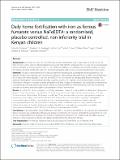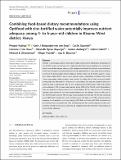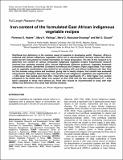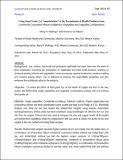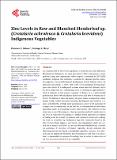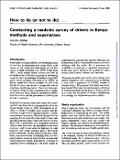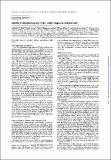School of Public health & Community Development: Recent submissions
Now showing items 281-300 of 439
-
Comparison of home fortification with two iron formulations among Kenyan children: Rationale and design of a placebo-controlled non-inferiority trial
(Elsevier, 2017-09-01)Introduction Home fortification powders containing iron and other micronutrients have been recommended by World Health Organisation to prevent iron deficiency anaemia in areas of high prevalence. There is evidence, however, ... -
Diagnostic utility of zinc protoporphyrin to detect iron deficiency in Kenyan preschool children: a community-based survey
(BioMed Central, 2017-12-01)Background Zinc protoporphyrin (ZPP) has been used to screen and manage iron deficiency in individual children, but it has also been recommended to assess population iron status. The diagnostic utility of ZPP used in ... -
Daily home fortification with iron as ferrous fumarate versus NaFeEDTA: a randomised, placebo-controlled, non-inferiority trial in Kenyan children
(BioMed Central, 2017-12-01)Background We aimed to show the non-inferiority of home fortification with a daily dose of 3 mg iron in the form of iron as ferric sodium ethylenediaminetetraacetate (NaFeEDTA) compared with 12.5 mg iron as encapsulated ... -
A survey of aflatoxin M1 contamination in raw milk produced in urban and peri-urban areas of Kisumu County, Kenya
(Taylor & Francis, 2018-01-01)Background: Food safety is of increasing global concern, and a OneHealth issue requiring attention of many disciplines. Aflatoxins are toxins produced by fungi and found in foods and feeds, and exposure causes negative ... -
Combining food‐based dietary recommendations using Optifood with zinc‐fortified water potentially improves nutrient adequacy among 4‐to 6‐year‐old children in Kisumu West …
(John Wiley & Sons Ltd, 2018-04)Children in developing countries often face multiple micronutrient deficiencies. Introduction of zinc‐fortified water can increase zinc intake, but additional recommendations are required to address overall diet nutrient ... -
Effectiveness of zinc-fortified water on zinc intake, status and morbidity in Kenyan pre-school children: a randomised controlled trial
(Cambridge University Press, 2018-10)Objective Zn deficiency and diarrhoea are prevalent and may coexist in children living in low-resource settings. Recently, a novel approach for delivering Zn via microbiologically treated, Zn-fortified water was shown to ... -
Adherence to home fortification with micronutrient powders in Kenyan pre-school children: self-reporting and sachet counts compared to an electronic monitoring device
(BioMed Central, 2018-11-01)Background The efficacy of home fortification with iron-containing micronutrient powders varies between trials, perhaps in part due to population differences in adherence. We aimed to assess to what extent adherence ... -
Efficacy of mycotoxin binder on aflatoxin M1 and Mazzican on total bacterial count in raw milk among smallholder dairy farmers in Kisumu County, Kenya
(ILRI, 2019-05-20)Background: Worldwide, milk forms a major part of human diet especially for children and expectant mothers. However, milk in East Africa has been shown to be frequently contaminated with aflatoxin M1 (AFM1) and bacteria. ... -
SUN-359 Antenatal Oral Iron Supplementation, FGF23 and Bone Metabolism in Kenyan Women and Their Offspring: A Randomised Controlled Trial
(Oxford University Press, 2020-04)Objectives: FGF23 decreases reabsorption and increases phosphate excretion in the kidney and regulates vitamin D metabolism. Maternal iron deficiency may be implicated in the pathogenesis of hypophosphataemia-driven rickets ... -
Exposure of children 4 to 6 months of age to aflatoxin in Kisumu County, Kenya
(AFRICAN SCHOLARLY SCIENCE COMMUNICATIONS TRUST (ASSCAT), 2015)Contamination of foods by aflatoxins is a global health problem in both developed and developing countries. Exposure to the toxins is associated with a range of effects on health including stunting in children. Commodities ... -
Iron content of the formulated East African indigenous vegetable recipes
(Academic Journals, 2009-12-31)Nutritional iron deficiency is the common cause of anaemia in developing world. However, Africa is endowed with African indigenous vegetables (AIVs) rich in micronutrients. Surveys within East Africa relate low AIV consumption ... -
Copper and Ascorbic Acid Content of Cooked African Indigenous Vegetables
(International Research on Food Security, Natural Resource Management and Rural Development, 2010)Malnutrition is common among women of childbearing age, it is made worse by micronutrient deficiency (Farm Africa, 2006). African Indigenous Vegetables (AIVs) are important for dietary diversification; they are a rich ... -
Iron and protein content of priority African indigenous vegetables in the Lake Victoria Basin
(David Publishing Company, Inc., 2010-08-01)African indigenous vegetables have many nutritional and health benefits that have not been well researched and fully exploited. The objective of this study was to determine iron and protein contents of seven priority ... -
Using Food Grade Lye “omushelekha” in the Formulation of Health Products from Commonly Consumed African Indigenous Vegetables and Vegetable Combinations
(Functional Foods in Health and Disease, 2011-05-24): Lye, sodium hydroxide and potassium hydroxide has been used over the years in food preparation including the preparation of vegetables and dried meat products, washing or chemical peeling of fruits and vegetables, cocoa ... -
Food preparation and processing methods on nutrient retention and accessibility in selected indigenous vegetables from East Africa
(Research gate, 2012)In Africa, indigenous vegetables are a common food source and rich source of micronutrients such as carotenoids, vitamin C, calcium and iron. However, food preparation and processing operations affect contents and ... -
Zinc Levels in Raw and Blanched Slenderleaf sp.(Crotalaria ochroleuca & Crotalaria brevidens) Indigenous Vegetables
(Scientific Research Publishing Inc., 2019)An estimated 20% of the world’s population is at risk for zinc (Zn) deficiency. Micronutrient deficiencies are most prevalent in Africa and remain a major problem facing poor populations, whose impact is worsened by ... -
PRESCRIPTION KNOWLEDGE AMONG PATIENTS WITH CARDIOVASCULAR DISEASES AT THE MOI TEACHING AND REFERRAL HOSPITAL, KENYA
(International Journal of pharmaceutical Sciences and Research, 2019)Cardiovascular diseases (CVDs) cause 30% of deaths globally and are reported to be on the increase in sub-Saharan Africa. Medications prescribed for a CVD require a lifetime commitment. As a result patient must adhere ... -
Road traffic accidents in Kenya: An epidemiological appraisal
(Nairobi Medical Association of East Africa, 1995)A descriptive analysis of road traffic accident (RTA) and injury data in Kenya was done using routine accident reports, official statistical abstracts, published and unpublished surveys. The characteristics of injury-producing ... -
Conducting a roadside survey of drivers in Kenya: methods and experiences
(Oxford University Press, 1996-09-01)Road traffic accidents (RTAs) are the leading cause of mortality in adolescents and young adults in all regions of the world and rank among the top five causes of death (Feachem et al. 1992; World Bank 1993). Traffic-related ... -
Injuries in developing countries: policy response needed now
(Royal Society of Tropical Medicine and Hygiene, 1996-11)How important are injuries? The World Health Organization (WHO) predicts that injuries will be responsible for more deaths, morbidity and disability combined than communicable diseases by the year 2020. Injuries currently ...



